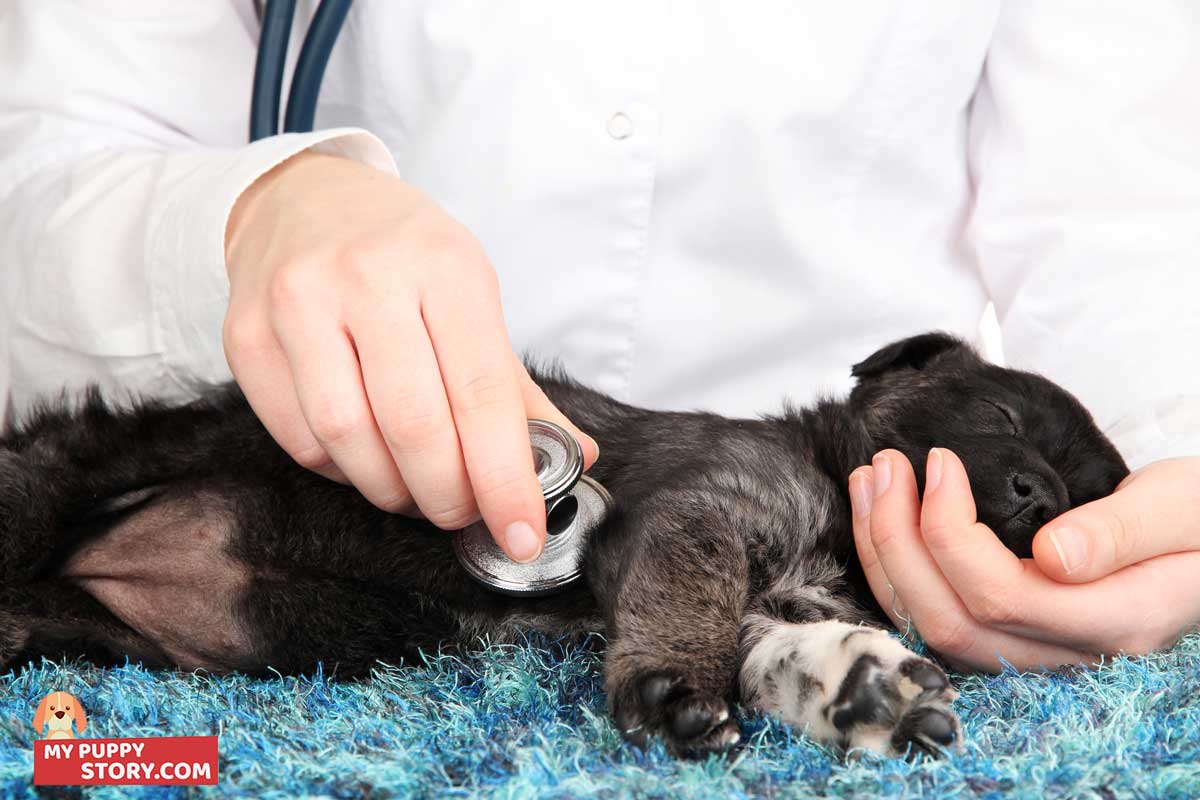
 When you bring a dog home from a store or shelter, or when you’re getting to know a brand new puppy, the last thing on your mind is taking care of him when he’s sick.
When you bring a dog home from a store or shelter, or when you’re getting to know a brand new puppy, the last thing on your mind is taking care of him when he’s sick.
Inevitably, though, something will happen. If you’re lucky it will be a minor problem like flea infection, which can be easily treated. If you’re like most dog owners, though, you’ll have to deal with more serious issues at some point in your pet’s life.
Dogs have the same major organs and systems that humans do, so many canine health problems are the same as the ones we experience. Other illnesses are specific to dogs and some are only seen in certain species; for example, we’ve never heard of a human developing Dancing Doberman Disease (which causes some Dobermans to flex their rear legs uncontrollably.)
The complete list of health challenges that dogs might face is so long that even a veterinarian would have trouble remembering all of them. But the short life span of canines means that potential issues will develop much sooner in your pet than they do in humans. Every dog owner should be familiar with the most common dog health problems, to be able to recognize symptoms or danger signs immediately.
Flea collars often prevent fleas and ticks from finding a new home on your dog and some will even treat infestations after they occur, but not all dogs will tolerate them and some dogs can’t wear them (if they’re puppies or pregnant, for example). The same is true for topical treatments. Newer prescription medications do a much better job of preventing flea infestations and tick bites. But of course nothing is foolproof, including the humans who have to remember to give the dog his flea pill.
So how do you know if your dog has fleas or ticks? And what to do next if there's an infestation?
 The symptoms of a flea problem are pretty easy to spot. They include repeated licking, biting or scratching of the skin, hair loss, and bare or oozing red skin patches known as flea allergy dermatitis or “hot spots.” You may even see tiny dark-colored dots on his fur, often called “flea dirt.” If it’s a tick issue your dog may have a fever, or constantly shake his head because ticks like to burrow into ear canals. When you see any of these symptoms, it’s important to take action quickly because one flea can become a thousand fleas in just a few weeks, and ticks can transmit serious Lyme disease.
The symptoms of a flea problem are pretty easy to spot. They include repeated licking, biting or scratching of the skin, hair loss, and bare or oozing red skin patches known as flea allergy dermatitis or “hot spots.” You may even see tiny dark-colored dots on his fur, often called “flea dirt.” If it’s a tick issue your dog may have a fever, or constantly shake his head because ticks like to burrow into ear canals. When you see any of these symptoms, it’s important to take action quickly because one flea can become a thousand fleas in just a few weeks, and ticks can transmit serious Lyme disease.
Some owners prefer natural treatments like flea and tick removal shampoo to kill the pests and then combing them all out of his fur. If you – or your dog – can’t or won’t deal with this routine, oral medications available from your vet can kill the fleas and ticks within six hours, and some topical treatments can get rid of them in a few days.
You’re not completely done, though. All of your pets will need treatment, and the house should also be completely treated, to make sure fleas aren’t hiding somewhere else and ready to come right back. Yes, it can be a pain – but isn’t your dog worth it?
There are other skin issues to be aware of, usually involving hot spots (if they’re not flea-related, they’re called moist dermatitis). They could be the result of an allergy or disease, a grooming issue, or even boredom for some long-haired breeds. Food allergies are often to blame, as is an environmental allergy common among golden retrievers, Labs and Shih Tzus called atropy which causes itching on the face, feet and belly.
You can try trimming hot spots and cleaning them with water-based antiseptic, but a better bet is to see the vet for some hydrocortisone spray or cream. This will ensure that there isn’t a deeper issue as hair loss can indicate anything from mites (which cause mange) to adrenal issues. Food allergies require an elimination diet, atropy is treated with medication. Your dog may need to wear a cone to prevent him from scratching the area until it heals.
Hair loss, usually on the tail, rear legs and trunk, is also a symptom of another relatively common disease in dogs: hypothyroidism. You’re right, the thyroid gland is in the neck but for some reason, when the gland becomes underactive, hair loss occurs toward a dog’s rear. Flaky skin, a dull coat and possibly black skin patches are also early signs of hypothyroidism, which as it progresses causes weight gain, infection and lethargy. If not treated, it can lead to seizures and heart problems as well.
Your vet will prescribe a daily oral hormone which your dog will have to take permanently without lasting effects. Hypothyroidism is most common in medium-to-large breed adult dogs, with spayed females and neutered males more prone to the disease.
When your dog starts vomiting without apparent reason or experiences constant diarrhea, chances are pretty good that it’s been caused by the consumption of contaminated food (experts call this “dietary indiscretion”). However, it can also indicate more serious issues.
Let’s look at vomiting first. If it’s a one-time occurrence, it’s probably fine to just clean up the mess and watch to make sure it doesn’t happen again – and don’t forget to check what he’s been eating. If there’s blood in the vomit, or the problem is combined with diarrhea or lethargy, a trip to the vet is called for. At the very least, dehydration could become a problem.
If the vomiting continues and is not an isolated issue, it’s definitely time to load the dog into the car for a visit to the veterinarian. It could be caused by anything from food allergies to bacterial or viral infections, from heat stroke to swallowing a foreign object. All call for professional diagnosis, as do more serious causes of vomiting like pancreatitis, intestinal bowel disease, liver or kidney failure, or life-threatening canine parvovirus. The latter is more likely to affect Labrador and American Staffordshire terriers, Rottweilers, Dobermans and German shepherds.
Diarrhea has some of the same causes as vomiting: dietary indiscretion, food allergies or recent change in diet, infection, foreign bodies, and many of the more serious illnesses we’ve already mentioned. It can also be a sign of something as benign as stress or as serious as cancer.
The first action you should take is withholding food and supplying plenty of fresh water to prevent dehydration. If the diarrhea continues for more than 24 hours, or if you also see signs of lethargy, straining while trying to defecate, vomiting or bloody stools, you know where to go next. Don’t even wait if it’s a puppy that has diarrhea (that could mean a serious disease), or if your older dog’s stool is black which could indicate internal bleeding.
You probably didn’t know this, but a dog’s ear canal is vertical and not horizontal like ours. That means it’s easy for all kinds of gunk to get stuck inside and cause an ear infection. Dogs who have allergies, lots of hair growth in the ear or floppy ears are most susceptible, but ear infections are regularly seen in all breeds. Yeast and bacteria are the most common culprits, although hair, mites and wax can also be responsible.
You should suspect an ear infection if your dog is scratching the area more than usual, if the area is red, swollen or crusty, or if there’s a colored discharge from the ear. More serious symptoms are prolonged head tilting, walking in circles or a loss of balance. Treatment usually involves an ear cleaning (the vet should do this, not you) and then medication.
Dogs have many of the same eye problems we do, and many are treated the same way. For conjunctivitis or pink eye, saline eye drops are the first line treatment, with prescription eye drops from your vet required if the problem continues for more than a couple of days. Occasional dry eye issues can be handled with artificial tears, but continuing problems call for a medication that stimulates the tear glands and occasionally surgery is required to move the dog’s tear ducts. Dogs can also get cataracts or suffer from glaucoma later in life, and they’re treated in basically the same way as they are in humans.
There are eye problems common in dogs that humans seldom or never have. Cherry eye is a red tear gland that can pop into view below a dog’s eye if the ligaments holding its third eyelid fail (yes, dogs have three eyelids). The problem is corrected with minor surgery.
Entropion is genetic and occasionally occurs in humans, but is more often seen in young dogs: a part of the eyelid becomes folded into the eye, allowing eyelashes to irritate the cornea and cause infections. Entropion can also be induced by repeated problems with conjunctivitis. Its symptoms include inflammation or excessive tearing in small dogs and gooey discharges from the eyes of large breeds. Both problems may be seen in medium-sized dogs. Antibiotics and artificial tears can help with mild cases, but surgery is often required.
Cataracts and glaucoma can cause blindness in dogs, of course. In some breeds, however, those problems are caused (usually at a young age) by a genetic disease called progressive retinal atrophy, which always leads to blindness. It’s similar to retinitis pigmentosa in humans, and most often seen in Samoyeds, Tibetan terriers and spaniels, Akitas, Papillons and miniature Dachshunds.
 You likely know that dogs are extremely prone to arthritis as they grow older; it’s one of the most common canine diseases treated by veterinarians. Many owners routinely give their mature dogs supplements like chondroitin and glucosamine even before they contract arthritis, and definitely after they are diagnosed. Because there’s no “cure” for the disease, treatment is aimed at lessening pain as much as possible, and can also include NSAIDs and steroids to reduce inflammation although each of those options can cause major side effects.
You likely know that dogs are extremely prone to arthritis as they grow older; it’s one of the most common canine diseases treated by veterinarians. Many owners routinely give their mature dogs supplements like chondroitin and glucosamine even before they contract arthritis, and definitely after they are diagnosed. Because there’s no “cure” for the disease, treatment is aimed at lessening pain as much as possible, and can also include NSAIDs and steroids to reduce inflammation although each of those options can cause major side effects.
One of the conditions that often leads to canine arthritis is hip dysplasia, a malformation of the ball-and-socket joint in the hip that’s usually caused by a mix of genetics, muscle mass and obesity. It’s quite common among large breeds like Labs, German Shepherds, Saint Bernards and Great Danes, and can either show at ages as early as 4-6 months, or in mature dogs when hip dysplasia is triggered by arthritis.
Difficulty in walking or climbing, odd gaits, loss of muscle mass in the thighs and development of larger shoulder muscles to compensate are all signs of hip dysplasia. The condition is diagnosed by a full workup including X-rays, and is treated primarily with pain relief and anti-inflammatory drugs, therapy and weight control in older dogs, with surgery an option for younger ones.
A similar condition, elbow dysplasia, causes malformation and eventual degeneration of dogs’ elbow joints and leads to pain and often lameness. Elbow dysplasia most commonly affects large and giant breeds, and usually is seen in both front legs. The problem occurs most often in younger dogs so surgery, followed by exercise therapy and diet, is a preferred treatment.
Issues seen in humans like Parkinson’s disease and nerve paralysis also affect dogs on occasion. Another disorder common to both, but seen fairly often in dogs, is epilepsy.
Canine epileptic seizures can be caused by a number of issues. Head injuries, anemia and blood sugar problems top the list, but epilepsy in dogs can also be triggered by poison, kidney or liver disease, encephalitis, strokes or cancer. Some breeds like German and Australian shepherds, collies, beagles and Labs can also have seizures without a diagnosable cause. As with humans, dogs can have either full-fledged grand mal or smaller focal seizures.
If your dog is having a seizure, don’t panic and don’t try to keep him from “swallowing his tongue” – dogs won’t choke during a seizure and may bite. Time the seizure (so you can tell your vet), pet and soothe him, cool him with a fan if the seizure lasts more than five minutes and wait for it to end. Then call your vet immediately. The usual treatment for dog epilepsy is medication that can damage the liver so regular blood tests will also be required. A normal life should be possible, however.
Some neurological diseases like distemper and rabies are well known and often fatal, but that’s why you have your dog vaccinated, right? Many other diseases are only seen in specific breeds including the Dancing Doberman disease we mentioned earlier, as well as a similar issue that hits Scottish Terriers known as Scotty Cramp.

It’s not unheard of for a dog to suffer a heart attack, but it’s extremely rare. About ten percent of all dogs do have heart issues, though, and by far the most common is valvular heart disease (VHD) which primarily affects older, small-breed dogs. The disease involves the thickening of heart valves so they’re unable to supply adequate blood to the body (known as congestive heart failure) and sadly, there are no early symptoms. VHD is a progressive disease which eventually causes loss of appetite, breathing problems, coughing and even fainting. Treatment can include diet modification, exercise, diuretics and medications like beta blockers, but there is no cure.
A genetic heart disease, subvalvular aortic stenosis (SAS), is sometimes seen in larger dogs like Rottweilers, golden retrievers and Newfoundlands. It is caused when abnormal tissue grows in the aorta, obstructing blood flow and causing congestive heart failure. The symptoms and progression of subvalvular aortic stenosis are similar to those of VHD and sadly, so is the prognosis. However, researchers are testing an unusual surgery using a balloon with blades attached to it to open the obstruction, and so far it has shown promise.
You may not be aware that many services are now available that offer genetic screening for dogs, and since researchers have identified the gene responsible for the development of SAS, it’s one of the mutations which can be identified through genetic screening.
Cancer doesn’t only affect us. 41% of Americans will contract some form of cancer during their lifetime – but 50% of dogs develop cancer after the age of 10. It’s the leading cause of death in older dogs.
Canine cancer can attack almost anywhere in the body, with lymphoma, skin cancer, breast cancer and bone cancer among the types most commonly seen. It’s believed that genetics are partly to blame, as some breeds are more susceptible than others. About 60% of cases are treatable or curable with surgery, radiation and chemotherapy, and other experimental techniques like tumor vaccines are also being tested.
As with humans, though, the best approach is prevention. That doesn’t mean you have to get your dog to stop smoking, of course, but the two best things you can do to protect your dog is to provide good dental care to prevent oral cancers, and spay females to reduce their risk of breast cancer.
